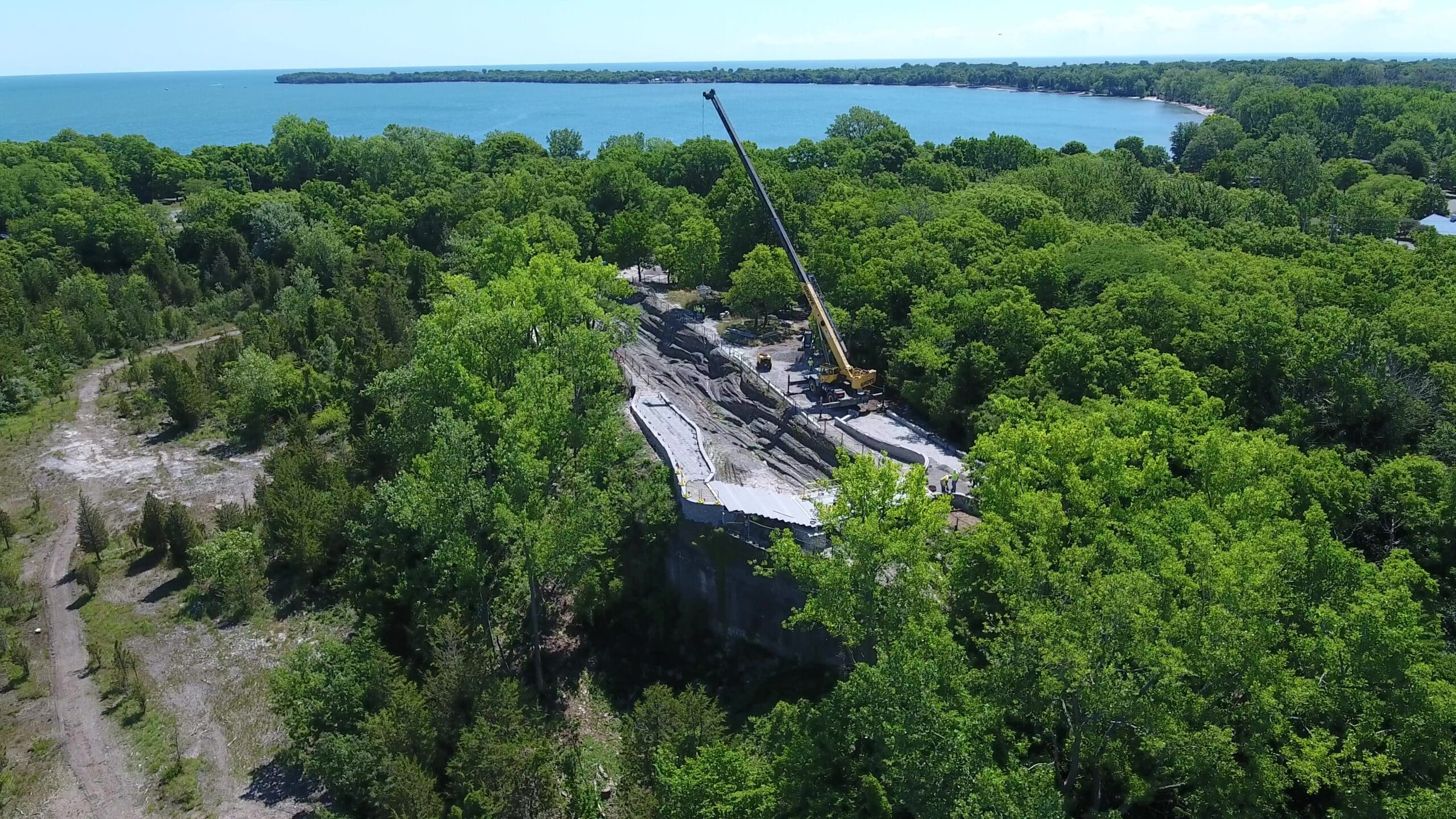March 18, 2024
The American Council of Engineering Companies of Ohio announced their Engineering Excellence Awards for 2024, selecting the Kelleys Island Glacial Grooves project in Kelleys Island, Ohio for an Honor Award.
Site Overview
 The Glacial Grooves Erosion Protection and Site Improvement project safeguards a National Natural Landmark from continuing erosion and degradation for future generations while delivering an immersive barrier-free viewing experience at this popular tourist attraction. Because of their large size and accessibility, the glacial grooves are arguably the most famous in the world and a critical feature to local residents, visitors, historians, scientists, and students alike. This geologic feature provides valuable information about the movement of the glaciers that shaped the landscape of the Great Lakes region.
The Glacial Grooves Erosion Protection and Site Improvement project safeguards a National Natural Landmark from continuing erosion and degradation for future generations while delivering an immersive barrier-free viewing experience at this popular tourist attraction. Because of their large size and accessibility, the glacial grooves are arguably the most famous in the world and a critical feature to local residents, visitors, historians, scientists, and students alike. This geologic feature provides valuable information about the movement of the glaciers that shaped the landscape of the Great Lakes region.
 The grooves have been exposed to weathering and erosion since fully excavated in 1972, with the original stairs, bridges, and perimeter fencing functioning for decades. Permanent protective measures were needed to address rock weathering, vegetation encroachment, surface water and seepage, and erosion. Site improvements were desired to replace aging infrastructure, improve site access, and provide better safety for visitors.
The grooves have been exposed to weathering and erosion since fully excavated in 1972, with the original stairs, bridges, and perimeter fencing functioning for decades. Permanent protective measures were needed to address rock weathering, vegetation encroachment, surface water and seepage, and erosion. Site improvements were desired to replace aging infrastructure, improve site access, and provide better safety for visitors.
The project team sought to integrate engineering solutions into the overall site elements, envisioning an opportunity to extend beyond protecting and preserving the feature.
Project Overview

S&ME was engaged by the Ohio Department of Resources (ODNR) to perform a limited duration study to document the conditions of the glacial grooves, to explore how the environment has impacted the grooves since exposure in 1972, and to inform a future course of action for protection and preservation of the grooves.
Following completion of the study, S&ME and our consultant team (CAP-Stone Associates and SMART Services) designed improvements to implement the Client’s goals of protecting and preserving the grooves and providing a safe and informative visitor experience while enhancing the focus on the natural features. S&ME developed conceptual design solutions and graphic depictions for stakeholder input, performed geotechnical investigations, evaluated the existing public access infrastructure, designed the segmental retaining wall bridge approaches, selected materials, prepared design drawings and bid documents, and developed and refined bid pricing for the unit rate contract. As part of the design contract, S&ME also performed cultural resource investigations in accordance with regulatory guidelines and coordinated with the Ohio SHPO and ODNR regarding threatened and endangered species.
Project tasks involved sensitive clearing of overgrown vegetation; demolition and removal of existing steel bridges, chain link fencing, miscellaneous site appurtenances; construction of a new custom fabricated two-span steel bridge, segmental block retaining wall bridge approach ramps, new ornamental and safety railing, gravel golf cart parking, geo-composite reinforced gravel pathways, paver plazas; installation of drainage improvements and educational kiosks.
Project Impact
This project implemented measures to protect and preserve the grooves, to reduce erosion, and to enhance visitor experience and safety. The elevated pedestrian bridge walkway and custom railing system facilitate an immersive visual experience, while the integrated stormwater management system directs runoff away from the grooves and protects the underlying fractured rock from erosion and groundwater infiltration.
The custom pedestrian bridge incorporates a mid- span forward-looking point to reflect the form of a glacier advancing over the land. At the forward pinnacle, visitors experience the natural history and culture of Kelleys Island, looking west across the historical quarry, and east and down vertically into the grooves.
 The site location five miles from the mainland in Lake Erie presented design and construction challenges. The unique logistics meant that all personnel, equipment, and materials were transported via a 40-minute seasonal and weather-dependent ferry boat trip.
The site location five miles from the mainland in Lake Erie presented design and construction challenges. The unique logistics meant that all personnel, equipment, and materials were transported via a 40-minute seasonal and weather-dependent ferry boat trip.
The site arrangement, design, and selection of materials sought to minimize the visual impact of the infrastructure while integrating engineering and stormwater management solutions and allowing the visual focus to remain on the glacial grooves and surrounding vistas.
